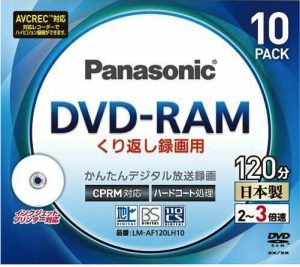History 2001: DVD-RAM Demise Greatly Exaggerated?
Given low sales volume since 1998
By Jean Jacques Maleval | February 28, 2023 at 2:01 pm“The end of DVD-RAM?” was the question we posed following Hanover’s CeBIT last March, given its low sales volume since 1998 – still in decline – as well as the arrival of Pioneer’s DVD-R/RW with such prestigious OEMs incorporating the unit in their PCs as Apple (replacing the DVD-RAM), Compaq, NEC/Packard Bell and now Sony.
Well guess what? It’s not over yet: the DVD-RAM is hanging on. Matsushita/Panasonic have in fact found a clever way to breathe new life in the technology, by making it read- and write-compatible with Pioneer’s general-use 4.7GB DVD-R. This wasn’t too difficult, since both media, the DVD-RAM and -R use the same 650nm laser diode.
Panasonic DVD-RAM 4.7GB

The new hybrid drive, the LF-D311 or DVDBurner model, faster than Pioneer’s unit, cost a bit less at $600 (in ATAPI internal version). There is nonetheless one major drawback: it cannot burn CD-Rs and -RWs for the moment.
Amidst all this activity, Matsushita in Japan launched a video recorder on DVD-R or DVD- RAM, the DMRE20, which should be available in the fall for $1,500. The device will allow recording of up to 6h of video on a 4.7GB disk.
There is thus now veritable competition between DVD-R/RAM and Pioneer’s DVD-R/RW.
The latter is currently focusing on delivering its DVR-A03 to OEMs and is expanding its China operations which began last May.
Distributors such as OPS or LaCie will soon have their orders filled. It’s fairly significant that a company like LaCie, until now completely committed to DVD-RAM, has now also entered DVD-R/RW, which it offers in USB or 1394 interface.
Media manufacturers also abound. Announcements for DVD-R disks have already come from JVC, Maxell, Mitsubishi Chemical/Verbatim, Panasonic, Pioneer, Ritek, TDK and Teijin, for a price around $15 (twice that for DVD-RW, at a price comparable to that of DVD-RAM media). Meanwhile, in the third camp for DVD+RW, led by Philips/HP, initial steps similar to Panasonic’s are underway.
The DVD+RW alliance has just added write-one capability to the DVD+RW format, but with a DVD+R which, although it could be played on most of the DVD video and DVD-ROM drives, is not compatible with Pioneer’s DVD-R (at least, not yet).
Delayed several times already, DVD+RW drives should, according to HP, be available on its Pavilion PCs this fall.
It is somewhat surprising to see the DVD+RW alliance rally around the write-once DVD its founders once judged to have no market…
It is no less odd to see Sony, which is a member of the latter group, announce that its most recent Viao notebook (over $3,000) would integrate… Pioneer’s DVD-R/RW.
On the other hand, the alliance has found a new ally in Dell Computer, a potential PC OEM in the future (as is HP), although it will have to await the arrival of the product, while its rivals are already integrating DVDRW units, which have become an essential element for selling a PC these days.
Swiss CD-R manufacturer Vivastar has had a brilliant idea of its own, to produce a drive designed exclusively for DVD-R, thus with fewer components, at a price 30% less than Pioneer’s.
For the moment, however, the idea hasn’t gotten beyond paper. The question then becomes whether or not CD-R technology is at the end of its lifespan with respect to DVD-R? Surely not. What no one is saying, or everyone is trying not to say, is that it is not possible to copy a DVD movie to a DVD-R, the way one can copy any audio CD onto a CD-R. DVD pirates would no doubt delight in finding a means of solving this dilemma, but it will be complicated (there is a copy-protection on each original DVD, as well as in writable DVD drives), not to mention slow, since the drive specs are far from stellar.
There is a delicate tension between, on the one hand, film producers seeking to prevent illegal copying and on the other, writable DVD manufacturers loathe to pass for resellers of illegal copying devices, all the while selling as many machines as possible.
The funniest aspect of all this is that certain companies, Sony for instance, are in both camps.
This article is an abstract of news published on issue 162 on July 2001 from the former paper version of Computer Data Storage Newsletter.














 Subscribe to our free daily newsletter
Subscribe to our free daily newsletter


